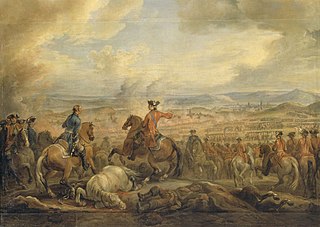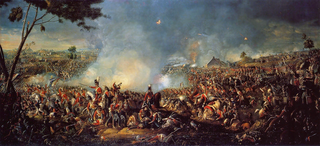 W
WThe 2nd Battle of Courtrai occurred during the War of the First Coalition near Kortrijk, Belgium, located about 85 kilometres (53 mi) west of Brussels.
 W
WThe Siege of Cuddalore was a siege attempt by British troops against a combined French and Mysorean garrison at the fortress of Cuddalore in the Second Anglo-Mysore War. The siege ended when news arrived of a preliminary peace treaty between France and Britain.
 W
WThe Battle of Dettingen took place on 27 June 1743 during the War of the Austrian Succession at Dettingen in the Electorate of Mainz, Holy Roman Empire. It was fought between a Pragmatic Army, composed of British, Hanoverian and Austrian troops, and a French army commanded by the duc de Noailles.
 W
WThe Battle of Fontenoy was a major engagement of the War of the Austrian Succession, fought on 11 May 1745, 8 kilometres (5.0 mi) outside Tournai, Belgium. A French army of 50,000 under Marshal Saxe defeated a Pragmatic Army of 52,000, led by the Duke of Cumberland. Along with his son the Dauphin, Louis XV of France was present and thus technically in command, a fact later used to bolster the regime's prestige.
 W
WThe Battle of Fontenoy, 11 May 1745, was a major engagement of the War of the Austrian Succession, fought between the forces of the Pragmatic Allies – comprising mainly Dutch, British, and Hanoverian troops, as well a relatively small contingent of Austrians under the command of the Duke of Cumberland – and a French army under the titular command of King Louis XV of France, with actual field command held by Maurice de Saxe, commander of Louis XV's forces in the Low Countries.
 W
WIn the Battle of García Hernández on 23 July 1812, two brigades of Anglo-German cavalry led by Major-General Eberhardt Otto George von Bock defeated 4,000 French infantry led by Major-General Maximilien Foy. In what would otherwise have been an unremarkable Peninsular War skirmish, the German heavy dragoons achieved the unusual feat of breaking three French squares, those of the 6th, 69th and 76th Line, routing the entire French force with heavy losses.
 W
WThe Fall of Ghent occurred on 15 July 1745 during the War of the Austrian Succession when a 5,000 strong French force under Ulrich Frédéric Woldemar, Comte de Lowendal surprised and captured the town of Ghent in the Austrian Netherlands. The Allied garrison offered little resistance.
 W
WThe Battle of Lauffeld, variously known as Lafelt, Laffeld, Lawfeld, Lawfeldt, Maastricht, or Val, took place on 2 July 1747, between Tongeren in modern Belgium, and the Dutch city of Maastricht. Part of War of the Austrian Succession, a French army force of 80,000 under Marshal Saxe faced a Pragmatic army of 60,000, led by the Duke of Cumberland.
 W
WThe Battle of Mouscron was a series of clashes that occurred when the Republican French Army of the North under Jean-Charles Pichegru moved northeast to attack Menen (Menin) and was opposed by Coalition forces under the overall leadership of François Sébastien Charles Joseph de Croix, Count of Clerfayt. In their initial advance, the French began the Siege of Menin and captured Kortrijk (Courtrai). With Habsburg Austrian reinforcements, Clerfayt counterattacked on the 28th but Joseph Souham soon massed superior French forces and drove the Coalition troops out of the area. This Flanders Campaign action happened during the War of the First Coalition, part of the French Revolutionary Wars. The battle occurred near Mouscron, Belgium, located at the French border 9 kilometres (6 mi) south of Kortrijk and at Menen, located 11 kilometres (7 mi) west of Kortrijk.
 W
WThe Battle of Rocoux took place on 11 October 1746 during the War of the Austrian Succession, at Rocourt or Rocoux, near Liège in modern Belgium. It featured a French army under Marshal Saxe and a combined British, Dutch, German and Austrian force led by Charles of Lorraine, John Ligonier and Prince Waldeck. The battle ended the 1746 campaign and the two armies went into winter quarters.
 W
WThe Siege of Nijmegen occurred from 27 October to 8 November 1794 during the Flanders campaign of the War of the First Coalition. It was the last major military confrontation between the forces of the Revolutionary French First Republic and the reactionary First Coalition of European monarchs including William V, Prince of Orange, before the fall of the Dutch Republic in January 1795, which William had ruled as hereditary stadtholder since 1751. As commander-in-chief of the Dutch States Army, his indecision, several changes of mind and lack of coordination with his Anglo-Hanoverian, Hessian, Prussian and Austrian allies contributed to the eventual surrender of Nijmegen to the French revolutionaries.
 W
WThe Battle of Tourcoing saw a Republican French army directed by General Joseph Souham defend against an attack by an Habsburg, British, and Hanoverian Coalition army under Austrian Prince Josias of Saxe-Coburg-Saalfeld and Prince Frederick, Duke of York and Albany. The French army was temporarily led by Souham in the absence of its normal commander Jean-Charles Pichegru. Threatened with encirclement, Souham and division commanders Jean Victor Marie Moreau and Jacques Philippe Bonnaud improvised a counterattack which defeated the Coalition's widely separated and badly coordinated columns. The War of the First Coalition action was fought near the town of Tourcoing, just north of Lille in northeastern France.
 W
WThe Battle of Waterloo was fought on Sunday, 18 June 1815, near Waterloo in Belgium, part of the United Kingdom of the Netherlands at the time. A French army under the command of Emperor Napoleon Bonaparte was defeated by two of the armies of the Seventh Coalition, a British-led coalition consisting of units from the United Kingdom, the Netherlands, Hanover, Brunswick and Nassau, under the command of the Duke of Wellington, referred to by many authors as the Anglo-allied army or Wellington's army, and a Prussian army under the command of Field Marshal von Blücher, referred also as Blücher's army. The battle marked the end of the Napoleonic Wars.